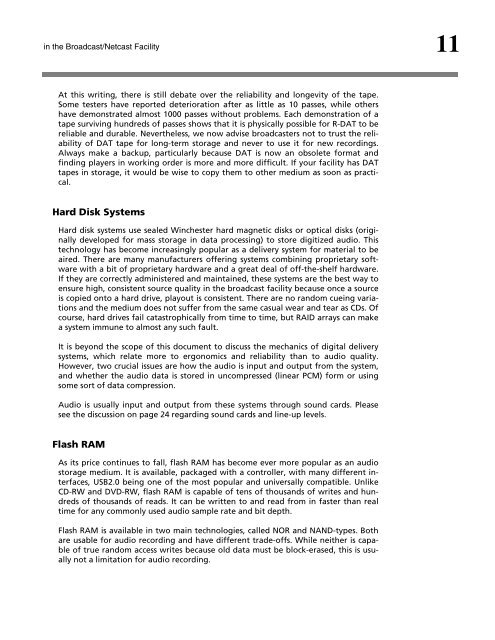Maintaining Audio Quality in the Broadcast Facility 2011 - Orban
Maintaining Audio Quality in the Broadcast Facility 2011 - Orban
Maintaining Audio Quality in the Broadcast Facility 2011 - Orban
Create successful ePaper yourself
Turn your PDF publications into a flip-book with our unique Google optimized e-Paper software.
<strong>in</strong> <strong>the</strong> <strong>Broadcast</strong>/Netcast <strong>Facility</strong> 11<br />
At this writ<strong>in</strong>g, <strong>the</strong>re is still debate over <strong>the</strong> reliability and longevity of <strong>the</strong> tape.<br />
Some testers have reported deterioration after as little as 10 passes, while o<strong>the</strong>rs<br />
have demonstrated almost 1000 passes without problems. Each demonstration of a<br />
tape surviv<strong>in</strong>g hundreds of passes shows that it is physically possible for R-DAT to be<br />
reliable and durable. Never<strong>the</strong>less, we now advise broadcasters not to trust <strong>the</strong> reliability<br />
of DAT tape for long-term storage and never to use it for new record<strong>in</strong>gs.<br />
Always make a backup, particularly because DAT is now an obsolete format and<br />
f<strong>in</strong>d<strong>in</strong>g players <strong>in</strong> work<strong>in</strong>g order is more and more difficult. If your facility has DAT<br />
tapes <strong>in</strong> storage, it would be wise to copy <strong>the</strong>m to o<strong>the</strong>r medium as soon as practical.<br />
Hard Disk Systems<br />
Hard disk systems use sealed W<strong>in</strong>chester hard magnetic disks or optical disks (orig<strong>in</strong>ally<br />
developed for mass storage <strong>in</strong> data process<strong>in</strong>g) to store digitized audio. This<br />
technology has become <strong>in</strong>creas<strong>in</strong>gly popular as a delivery system for material to be<br />
aired. There are many manufacturers offer<strong>in</strong>g systems comb<strong>in</strong><strong>in</strong>g proprietary software<br />
with a bit of proprietary hardware and a great deal of off-<strong>the</strong>-shelf hardware.<br />
If <strong>the</strong>y are correctly adm<strong>in</strong>istered and ma<strong>in</strong>ta<strong>in</strong>ed, <strong>the</strong>se systems are <strong>the</strong> best way to<br />
ensure high, consistent source quality <strong>in</strong> <strong>the</strong> broadcast facility because once a source<br />
is copied onto a hard drive, playout is consistent. There are no random cue<strong>in</strong>g variations<br />
and <strong>the</strong> medium does not suffer from <strong>the</strong> same casual wear and tear as CDs. Of<br />
course, hard drives fail catastrophically from time to time, but RAID arrays can make<br />
a system immune to almost any such fault.<br />
It is beyond <strong>the</strong> scope of this document to discuss <strong>the</strong> mechanics of digital delivery<br />
systems, which relate more to ergonomics and reliability than to audio quality.<br />
However, two crucial issues are how <strong>the</strong> audio is <strong>in</strong>put and output from <strong>the</strong> system,<br />
and whe<strong>the</strong>r <strong>the</strong> audio data is stored <strong>in</strong> uncompressed (l<strong>in</strong>ear PCM) form or us<strong>in</strong>g<br />
some sort of data compression.<br />
<strong>Audio</strong> is usually <strong>in</strong>put and output from <strong>the</strong>se systems through sound cards. Please<br />
see <strong>the</strong> discussion on page 24 regard<strong>in</strong>g sound cards and l<strong>in</strong>e-up levels.<br />
Flash RAM<br />
As its price cont<strong>in</strong>ues to fall, flash RAM has become ever more popular as an audio<br />
storage medium. It is available, packaged with a controller, with many different <strong>in</strong>terfaces,<br />
USB2.0 be<strong>in</strong>g one of <strong>the</strong> most popular and universally compatible. Unlike<br />
CD-RW and DVD-RW, flash RAM is capable of tens of thousands of writes and hundreds<br />
of thousands of reads. It can be written to and read from <strong>in</strong> faster than real<br />
time for any commonly used audio sample rate and bit depth.<br />
Flash RAM is available <strong>in</strong> two ma<strong>in</strong> technologies, called NOR and NAND-types. Both<br />
are usable for audio record<strong>in</strong>g and have different trade-offs. While nei<strong>the</strong>r is capable<br />
of true random access writes because old data must be block-erased, this is usually<br />
not a limitation for audio record<strong>in</strong>g.



![[PDF] Using the ITU BS.1770-2 and CBS Loudness Meters ... - Orban](https://img.yumpu.com/50629372/1/190x245/pdf-using-the-itu-bs1770-2-and-cbs-loudness-meters-orban.jpg?quality=85)






![[PDF] Optimod-FM Feature Comparison - Orban](https://img.yumpu.com/41741615/1/190x245/pdf-optimod-fm-feature-comparison-orban.jpg?quality=85)






